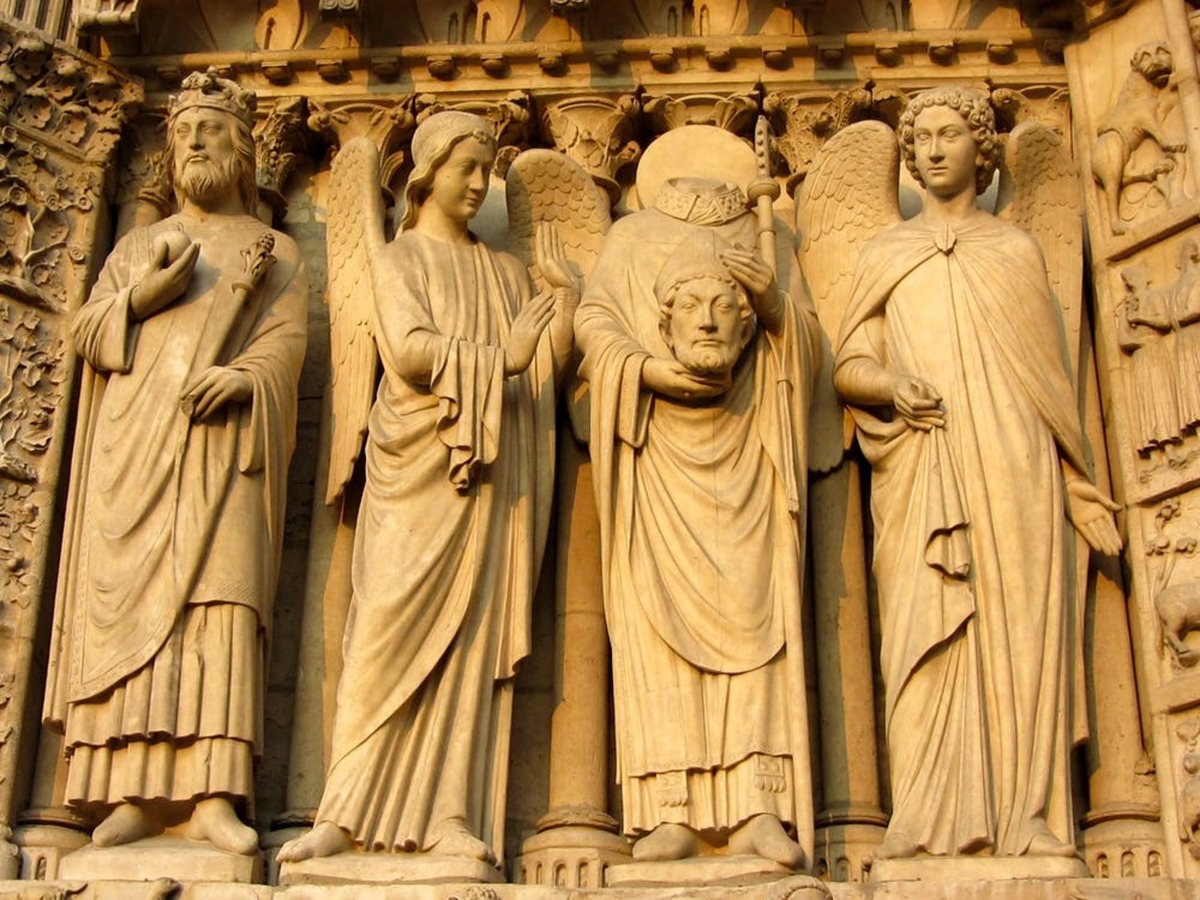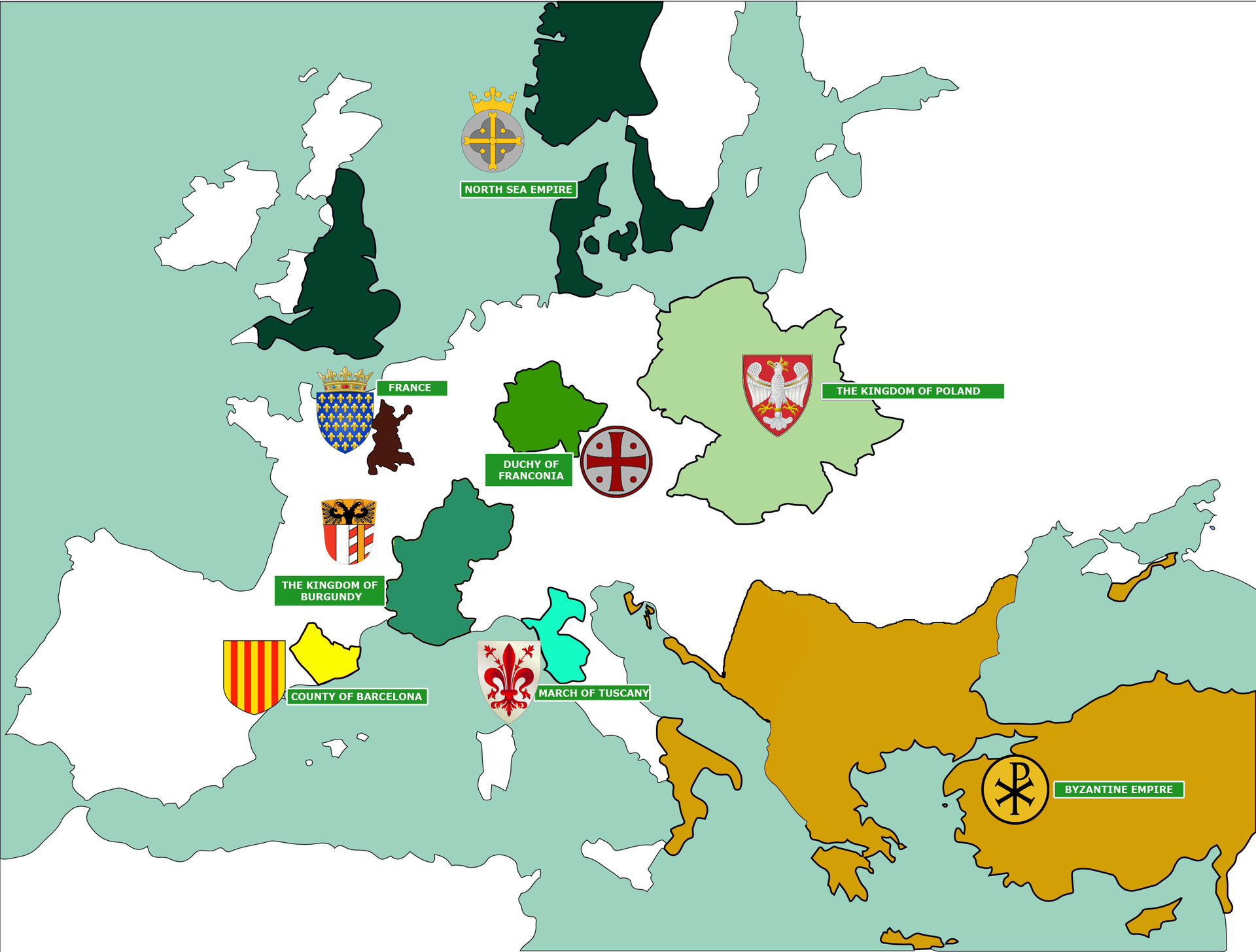The European Championship 1030
In the medieval Europe Christening was a political act of “joining” the rest of “civilized world” but it also guaranteed the survival because pagans could have chosen between the extinction or receiving Christianity since Christian rulers and knights had the pope’s blessing to take control over a territory in the name of Christianity.
The former West and East Francia developed into the France with Capet dyanasty on the throne and (Holy) Roman Empire with the Saxon dynasty who was later succeed by the Salian dynasty. In the first half of 11th century the Polish king dominated the Middle East Europe. In comparison, the Danish king Knut ruled the North Sea and Baltic establishing his dominance in Norway and England. Land of the Rus at the east and Islamic The Umayyad Caliphate at the Pyrenees Peninsula were involved in civil throne wars. Sicily and the south of the Apennine Peninsula were invaded by adventurers, arriving from French Normandy, who chased away Byzantines and Saracens from this area. Rulers started to embrace Christianity in the middle, east and north Europe at the end of the 10th and the beginning of the 11th century. In kingdom of Poland, this happened during Mieszko’s reign, in Hungary during Vaik’s reign (later known as King Saint Stephen I), in the kingdom of Denmark during Halard Bluetooth’s, in the kingdom of Norway during Olaf Tryggverson’s and in the kingdom of Sweden during Olaf Skortkonun’s reign. In comparison, grand prince of Kiev received Christianity from Byzantium as well as Bulgarian and Serbian rulers.
As it was mentioned earlier, christening was a political act of “joining” the rest of “civilized world”. In comparison to elites, the process of receiving Christianity by the rest of people lasted for centuries. Moreover, even after receiving Christianity, numerous people still preserved their pagan customs and believes. Violent christening of pagans was accompanied by banning pagan cults, prosecutions and massacres. Since pagans preserved their customs and believes even after christening, in addition to missionary work, the Church used religious compromises, i.e. it took attributes and symbols of pagan deities, attributed “historical events” to them, renamed them and attributed their stories to its saints. Christianity was spread by creating a cult of saints whose life stories of bravery, sacrifices, compassion and humanity served as life models for people. Furthermore, saints were perceived as protectors in difficult times such as with illnesses, protection of people, field, animals, etc. Cults of martyrs were especially important because their deaths served as examples of true devotion to the religion. Saint relics (their remains or possessions) started to be worshiped because it was believed that they can give blessings or perform miracles. Christianity was perceived not only as a religious community of people believing in God but as a phenomenon of all humanity ancestors and the “Holy Land” (Judea or Palestine) which is important for Christians. Additionally, “racial” genealogy was created with Noah being Adam’s successor and Noah’s sons the founders of human “races”. Europeans originated from Jafet, Asians from Sem, Africans, who were cursed to be slaves, from Ham. Clerics believed that language diversity was a consequence of the first sin, which was Babilon’s fault.

Sources
- Mladen ANČIĆ, Što "svi znaju" i što je "svima jasno" : historiografija i nacionalizam, Zagreb, 2008.
- Marijana BELAJ, ''Sveta mjesta, sveto vrijeme, sveti ljudi'', Slavonija, Baranja i Srijem - Vrela europske civilizacije, I.sv, (ur: Božo Biškupić, Vesna Kusin, Branka Šulc) Zagreb, 2009.
- Marc BLOCH, Feudalno društvo, Zagreb, 2001.
- Neven BUDAK, Tomislav RAUKAR, Hrvatska povijest srednjeg vijeka, Zagreb, 2006.
- Umberto ECO, Konstruiranje neprijatelja i drugi prigodni tekstovi, Zagreb, 2013.
- Jacques LE GOFF, Civilizacija srednjovjekovnog Zapada, Zagreb 1998.
- Marko PIJOVIĆ, ''Demistificiranje ''etniciteta'' '', Historijska traganja, 10/2012.
- Philippe WALTER, Kršćanska mitologija : svetkovine, obredi i mitovi srednjega vijeka, Zagreb, 2006.
- Deniver Vukelić, ''Pretkršćanski prežici u hrvatskim narodnim tradicijama'',
- (http://www.matica.hr/hr/360/PRETKR%C5%A0%C4%86ANSKI%20PRE%C5%BDICI%20U%20HRVATSKIM%20NARODNIM%20TRADICIJAMA%20/)
- ''Kako su potomci fanatičnih ratnika postali vjerski ravnodušni realisti'', http://www.tportal.hr/kultura/knjizevnost/345862/Kako-su-potomci-fanaticnih-ratnika-postali-vjerski-ravnodusni-realisti.html
- ''Nastanak kulta i čašćenja svetaca'',( http://www.pobijeni.info/userfiles/Nastanak-kulta-i-cascenja-svetaca.pdf)
- ''Relikvije'', ( http://www.enciklopedija.hr/Natuknica.aspx?ID=52388
Sources for a map:
- Stem duchy: https://en.wikipedia.org/wiki/Stem_duchy
- 1000 Europe i Francuska: https://sites.google.com/a/umich.edu/imladjov/maps
- Italy: http://www.zum.de/whkmla/histatlas/italy/haxitaly.html
- Catalonia: https://sites.google.com/site/historyforlarra2/home/unit-4-the-iberian-peninsula-from-the-8th-to-the-11th-centuries
- France https://commons.wikimedia.org/wiki/File:France_1154-en.svg
- Poljska: http://epicworldhistory.blogspot.hr/2012/10/poland.html
- Byzantium:
- Bizant: https://en.wikipedia.org/wiki/Duklja; https://www.reddit.com/r/MapPorn/comments/720g2c/map_i_hand_drew_of_the_byzantine_empire_in_1025/
Source for picture: https://www.pexels.com/photo/the-greek-statues-60035/
